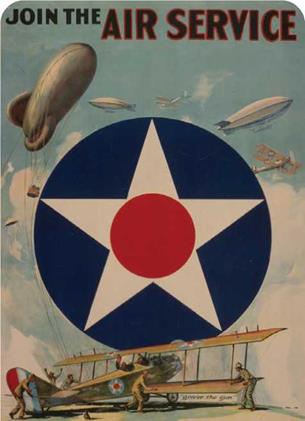World War I
|
W |
orld War I began in Europe in 1914, and the United States entered the war in 1917. Remembered for the terrible slaughter of trench warfare on the Western Front, the “Great War,” as World War I became known, was the first war in which airplanes played an important part.
|
|
LEARN-EARN
О A World War I poster encourages volunteers to enlist in the Air Service, part of the U. S. Army. At the time, there was no separate U. S. Air Force. The poster reflects the aircraft of the period, including airships.
The Role of Aircraft
Until 1914, military strategists regarded command of the sea as the key factor in international warfare. Britain, Germany, and the United States had the biggest navies. When World War I began, airplanes were still a novelty. The fastest airplane had a top speed of only 100 miles per hour (160 kilometers per hour) and a range of about 100 miles (160 kilometers) before needing to refuel.
In the nineteenth century, balloons and airships had been used in wars, mostly for observation and for evacuation of civilians. The military had yet to find uses for the airplane. In 1912, Britain had set up a Royal Flying Corps, but it had very few aircraft. Germany had the largest air force, with more than 200 airplanes plus Zeppelin airships. The U. S. Army had purchased its first airplanes in 1913. No nation had assembled a large air force.
In the four years of World War I (1914-1918), the airplane became a much more formidable weapon. Fighter planes battled in aerial combats called dogfights. For the first time, cities were bombed from the air by airships and airplanes. The warring nations formed air forces or aviation divisions within their armies and navies. War would never be the same again.











